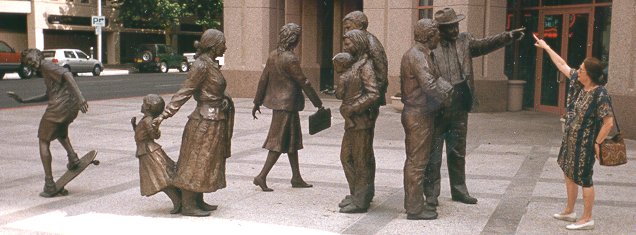Looking for Reality
Today, we try to tell fact from fiction. The University of Houston's College of Engineering presents this series about the machines that make our civilization run, and the people whose ingenuity created them.
Computer-generated special effects had hardly touched the movies back in 1987. That year I heard Ken Torrance from Cornell University talk about his work on computer graphics. At the time, he was creating simple still pictures -- a crib in a room, a jar on a table. He'd written the complicated equations for the reflection and diffusion of light. To illuminate his scenes, he let a computer chew through those terrible equations until it cast light in the same way as a lamp or the sun might do.
By then, the computer pictures we'd seen in the movies had an odd property. Glints of reflected light were all white. Real objects give some of their color to the light they reflect. Only a few materials, like plastics, reflect light without changing it. So graphic artists talked about the plastics problem.
Torrance had beaten that problem. His colors reflected correctly. They mixed perfectly in the shadows. His pictures had the beauty and accuracy of a Dutch master. When I saw his images, I didn't know whether I was looking at a picture or the thing itself. They weren't an artist's creation. He'd written the rules of nature and then let the computer obey those rules. In a sense he'd told the computer how to recreate reality by recreating nature.
Today, we've come so far in the difficult task of parsing reality into computer language that the results are more than just stunning. They're also disorienting. Computers now show us how fluids move over airfoils, through tubes, past turbine blades. As they take us through the tortuous slow-motion swirls of water and air, we might wonder whether we're seeing reality or the imaginings of a lunatic. Yet those images can be more accurate than our imperfect attempts to isolate processes in the laboratory.
While the computer's role in our lives expands faster than we can follow it, we adopt the language of people dealing with real things. We speak of doing numerical experiments. We're disarmingly casual about separating computer and laboratory data. Computers take larger and larger roles as partners in human decision-making.
In 1987, I wondered where people like Torrance were taking us. Since then it's grown steadily harder to tell whether we're looking at a picture created by an artist, a camera, or a computer. Computers can make the sound of a concert grand piano that fools me. As computers speak to our senses as well as our minds, the line between realities inside and outside the machine keeps blurring.
So Torrance fired a warning shot. Today, I think less about change, for change has enveloped me like a misty day. Whether we watch the latest Godzilla or Grand Opera, we expect reality to be extended electronically. Once we accepted the movie convention of a model ship sinking in a bathtub. It wasn't because our mind was fooled. Rather, our mind completed the illusion. And that is the task which the computer has so disturbingly taken over.
I'm John Lienhard, at the University of Houston, where we're interested in the way inventive minds work.
(Theme music)
This is a revised and updated version of Episode 88.

Photo by John Lienhard